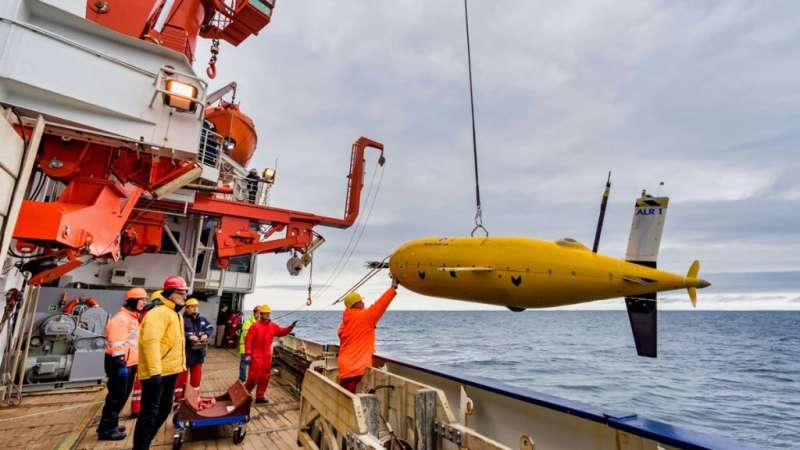Exploring a warm water inflow below an Antarctic ice shelf

The cold, dense water circulating under Antarctica's Filchner-Ronne Ice Shelf (FRIS) keeps under-ice melting there to a minimum, helping the ice shelf act as a regulating force against the Antarctic Ice Sheet's contribution to global sea level rise.
FRIS accounts for 10% of all ice discharge from the Antarctic Ice Sheet. Although it is stable today, climate models predict that ocean currents may shift in the future, possibly ushering large volumes of relatively warm water into the cavity beneath the ice shelf.
Currently, only a single narrow band of warmer water, called Modified Warm Deep Water (MWDW), makes its way to the front of the ice shelf. However, the drivers of this current and its effect on under-ice melting are not well understood.
Peter Davis and colleagues used the Autosub Long Range autonomous underwater vehicle (AUV) to capture the first measurements of the MWDW and surrounding waters beneath FRIS. The AUV collected high-resolution data on the current's velocity and turbulent nature, its mixing efficiency, and the vertical heat flux occurring beneath FRIS.
The researchers found that the core of MWDW flows underneath FRIS at 4 centimeters per second and that this warm water reaches at least 18 kilometers into the cavity under the ice shelf. The team also found that tides affect the inflow and mixing of the MWDW with surrounding waters, producing patchy, spatially heterogeneous hydrographic properties under the ice, with the highest rates of thermal dissipation and vertical mixing occurring where the current is the warmest.
This survey provides a unique snapshot of the waters under FRIS. However, the researchers note that additional studies, including higher-resolution AUV surveys taken over longer periods of time, will help scientists better understand the nature of MWDW flow under the ice shelf—which is especially important in a warming climate.
The findings are published in the Journal of Geophysical Research: Oceans.
More information: Peter E. D. Davis et al, Observations of Modified Warm Deep Water Beneath Ronne Ice Shelf, Antarctica, From an Autonomous Underwater Vehicle, Journal of Geophysical Research: Oceans (2022). DOI: 10.1029/2022JC019103
Provided by Eos
This story is republished courtesy of Eos, hosted by the American Geophysical Union. Read the original story here.



















